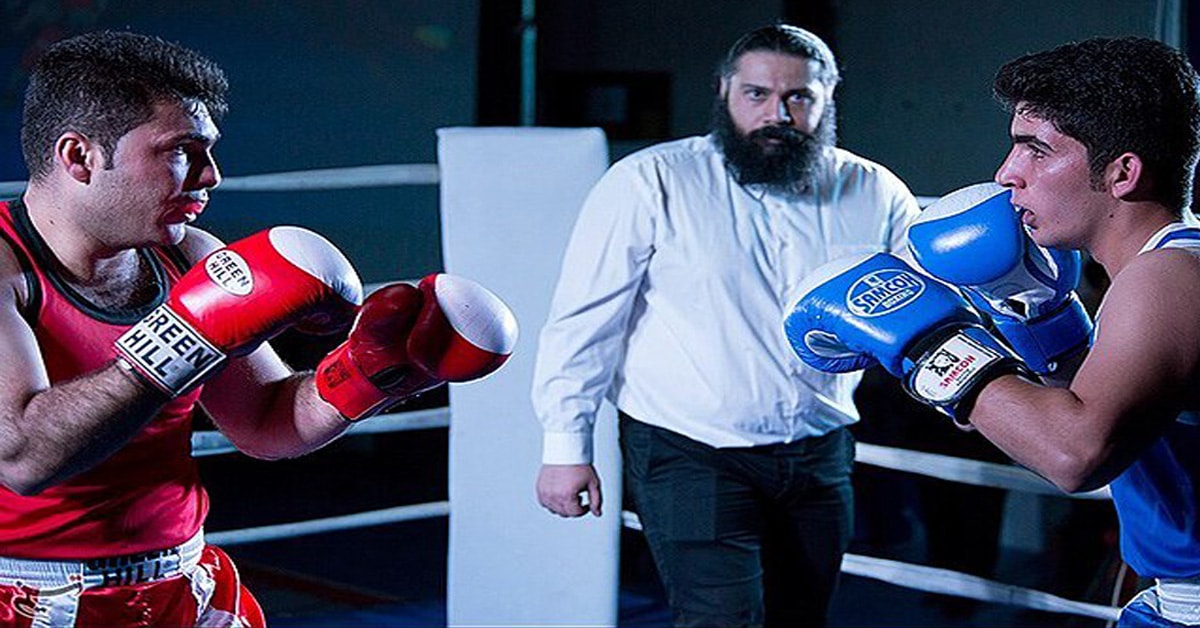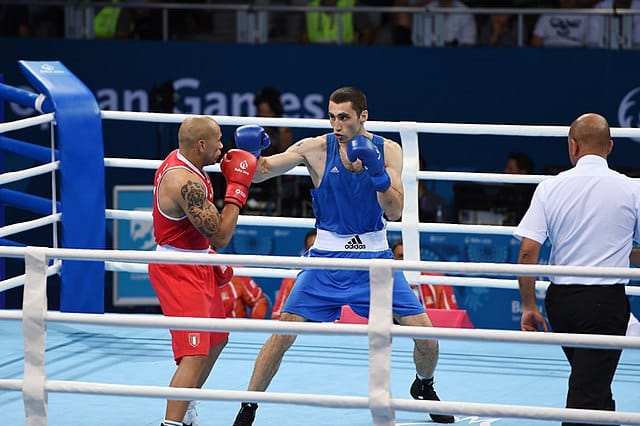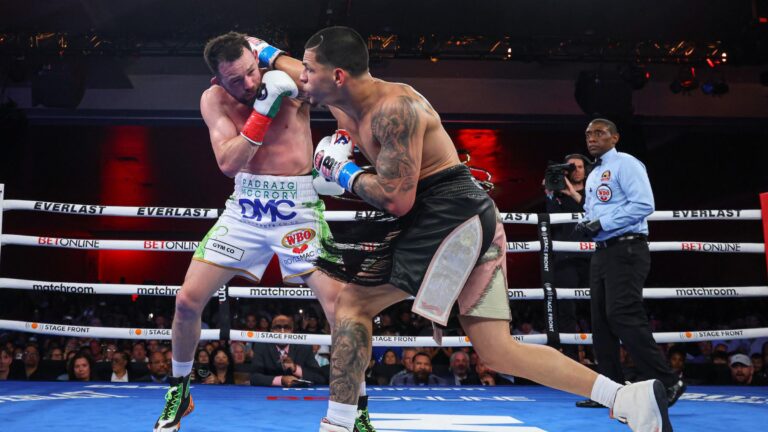Boxing Stances: Explained

Boxing stances are the foundations for a boxer to develop their abilities. New boxers often have questions about their stance, and we will break it down for them.
Here’s an explanation of the different boxing stances detailing their characteristics and strengths. Below also includes gameplans for beating the different boxing stances and answering which one is the best.
How Many Boxing Stances Are There?
There are two types of boxing stances, which, in normal phrasing, are right-handed or left-handed. In boxing, a fighter is classified by having an orthodox(right) or southpaw stance(left).
Then, within those two boxing stances, fighters have adapted different ways to stand in them to match their style.
The Boxing Stances
Here’s a brief explanation of the different boxing stances.
Orthodox Boxing Stance

The right-handed or orthodox boxing stance is where your right hand is in the back, and your left is leaning. This means your left foot is the lead, while your right is in the back.
In an orthodox boxing stance, your lead left moves first to go forward or to the left. Your back right foot moves first to go backward or to the right.
Strengths of an Orthodox Boxing Stance
Most Common Stance
The orthodox stance is the most common of the two boxing stances. Being the majority gives orthodox fighters the advantage of training with partners with the same stance.
This gives them the advantage of quickly developing their fundamentals and defenses against other orthodox fighters because it’s easier.
Positioning
Another top strength of the orthodox stance is the positioning of your left hand. Since the left hand is leading, this gives orthodox fighters the strength to target their opponent’s left side.
Specifically, the liver that’s located on the right side of the body.
Southpaw Boxing Stance

The southpaw boxing stance is where your left hand is placed in the back with your right hand leading. Since your right hand is in front, this coincides with your right foot being in front and left in the back.
To move in a southpaw boxing stance, your lead moves forward and to the right. Your back foot moves first to move backward and to the left.
Strengths of a Southpaw Boxing Stance
Open Stance
The strength of the southpaw stance is that it’s more open than an orthodox stance. This means that against an orthodox opponent, a southpaw steps to the outside of their opponent’s lead foot.
Moving this way enables a southpaw’s stance to be open while avoiding their orthodox opponent’s power hand.
Different Movement
Being the least common of the two boxing stances gives the southpaw stance an advantage. Most boxers stand orthodox, which means they are accustomed to the movements of their stance.
The movement of a southpaw is the reverse of an orthodox, which can throw off a right-handed opponent.
Alterations to Boxing Stances
To add to the complexity of boxing stances, different boxing styles are used in combination with them. We won’t go in-depth on boxing styles but briefly overview their characteristics.
Hand Placement
Hand placements can vary within the boxing stances. Boxers can have different styles where their hands from wide to tight.
Then there are hybrids like the Philly shell stance, where the lead hand is down to create a counter-trap.
Foot Placement
Foot placement in the boxing stances dictates the types of fighters young boxers will become. You have either a balanced stance, an aggressive stance, or a defensive stance.
- Balanced Stance: A balanced boxing stance is a classic style where a boxer’s weight is equally distributed between their feet. Ready to go from aggressive to defensive, depending on the situation.
- Aggressive Stance: An aggressive boxing stance is characterized by the back heel being up and more weight on the lead foot.
- Defensive Stance: In a defensive stance, your weight is more on your back foot as you wait to counter your opponent’s attacks.
Crouching Stance vs. Upright Stance
In their boxing stances, fighters will choose between being in a crouching stance or an upright stance. Taller fighters generally stand more upright, and shorter fighters choose to crouch to remove an opponent’s targets.
Wide Stance vs. Narrow Stance
Along with being crouched or upright, boxing stances can also be narrow or wide. Fighters with wide stances like to use their range, while fighters with a narrow stance like in-close fighting.
Gamplans For Beating the Different Boxing Stances
There are specific game plans fighters follow to beat the different boxing stances. Here is how you can beat them, whether an opponent is in the same or opposite view.
How to Beat the Orthodox Stance
Move Right
If you’re a southpaw fighting an orthodox opponent, your goals should be to move to the right.
Avoid Right Hand
The kryptonite on the southpaw is the straight hand. Orthodox boxers have a clear path to the southpaw’s chin.
It’s extremely important that a southpaw be aware of their opponent’s right hand and avoid it. If a southpaw does this, they’ll be statistically more likely to beat an orthodox opponent.
Win Foot Battle
When southpaw and orthodox boxing stances meet one another, the southpaw must win the battle of foot positioning. A southpaw must keep their lead foot on the outside of the opponent’s lead foot.
Doing this gives the southpaw a clear path to land their cross. This also gives them a path to step out of danger.
How to Beat the Southpaw Stance
Straight Right
The best way to beat a southpaw is by landing a straight right hand. As mentioned before, the right cross is the kryptonite of southpaw fighters.
If an orthodox fighter finds a home for their right hand, they’ll win.
Left Hook to the Body
To go along with the power right hand, the orthodox fighter has a shorter path to land a hook to the body.
Since a southpaw stance brings the right side of the body closer to their opponent. All an orthodox boxer has to do to land it is slip the jab and rip.
Win Foot Battle
Just like with southpaws, an orthodox fighter must also win the foot battle. They cannot let the southpaw get on the outside of their lead foot.
They need to keep their foot on the outside to shut down the left cross and escape route.
How to Choose Your Boxing Stance
You can choose which boxing stance you’ll use by simply remembering what hand you write with. Whatever hand you write with is usually your dominant hand, which is placed on your chin.
Some outlying young boxers may reverse this and make their dominant hand their lead.
A boxing coach will generally teach a new student with their dominant hand in the back to develop a base. Once that student understands the mechanics of this boxing stance, they can learn the other.
Which Boxing Stance is the Best
The boxing stances have their strengths and weaknesses, but neither is better. What matters is the technique of the fighter. If a fighter has good technique, they can make either stance effective.





